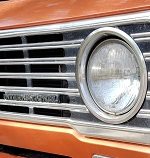|
H110Hawk posted:Somewhere in your house is a transformer feeding power to the box, or a battery in the box, or both. Find that, unplug it, undo the battery, and then you should be good to just snip wires into the walls. Do you have a multi-meter? Checked the box and all the hot wires were disconnected, then it occurred to me that it might not be the security siren, it might be a hardwired smoke alarm. And it was! No idea what set it off but I guess it was just a false alarm.
|
|
|
|

|
| # ? May 24, 2024 07:38 |
|
Friend posted:Checked the box and all the hot wires were disconnected, then it occurred to me that it might not be the security siren, it might be a hardwired smoke alarm. And it was! No idea what set it off but I guess it was just a false alarm.  I would inspect electronics in the same room or hallway as the alarm(s) especially if they're linked, make sure something didn't seriously give up the ghost. Acrid smells are a key indicator. As are black stains on the walls.
|
|
|
|
We are building an addition that I needed to post a thread about and we are now at the stage where I am installing lighting fixtures. We bought two wall sconces from this Etsy shop: https://www.etsy.com/shop/CrescentBrightness When I went to wire them I found blue and brown wires which I figured out but in doing so I realized i can't find any type of UL or ETL etc certification. How much of a problem is this? I got worried about our other fixtures and found 2/3 of those list UL and/or ETL cert on the Wayfair page we bought them from. All of these are just getting LED bulbs so they shouldn't be drawing a lot of power. Please he;lp me not make assumptions/house fires not covered by my insurer.
|
|
|
|
Being UK based all those fixtures will be CE compliant, as everything has to be by law. CE is the euro version of UL but the two things are not necessarily interchangeable. Inspectors will check for the mark specific to your region and may flag it up for not having it, even though it is almost certain to satisfy the requirements for it. e: checking some at random it seems like some of what they sell does have UL certification, I guess based on where they sourced them from kecske fucked around with this message at 16:28 on May 18, 2023 |
|
|
|
kecske posted:Being UK based all those fixtures will be CE compliant, as everything has to be by law. CE is the euro version of UL but the two things are not necessarily interchangeable. Inspectors will check for the mark specific to your region and may flag it up for not having it, even though it is almost certain to satisfy the requirements for it. Being from that shop it would seem it's much more likely to be a China Export stamp rather than a Conformitť Europťenne mark. I'm not too concerned about simple incandescent light fixtures if they appear to be reasonably well made, but anything more than that should be certified for use in your country if you're going to attach it to mains voltage.
|
|
|
|
CE marking is mandatory here, its a legal requirement that anything sold that falls under the scope (all electrical goods do) has one.https://www.cemarkingassociation.co.uk/ce-marking-and-the-chinese-export-logo/ posted:The CE Marking Association has held the view for a long time that the China Export mark is not a valid mark and it is actually just the European CE mark that does not respect the dimensions and proportions given within the Directives. Our view is also supported by the European Parliament, who were asked to respond to questions related to the ‘China Export’ mark. In summary they believe there is a misconception about the CE mark meaning ‘Chinese export’ and they go on to say that the Commission is not aware of the existence of a ‘China export mark’. kecske fucked around with this message at 17:37 on May 18, 2023 |
|
|
|
kecske posted:CE marking is mandatory here, its a legal requirement that anything sold that falls under the scope (all electrical goods do) has one. Yet regardless of such requirement there are troves of examples where the intentionally similar China Export stamp is what is in fact on those goods.
|
|
|
|
The bulb base and wires might be legitimately ul/ce/etl stamped but the whole fixture isn't. Double check the wiring but otherwise you're not going to be wrong enough to burn down your house as long as the metal lamp bits to ground shows 0VAC when lit. If it shows <electrocuting/screaming noises> then yeah return it and report the seller.
|
|
|
|
Motronic posted:Yet regardless of such requirement there are troves of examples where the intentionally similar China Export stamp is what is in fact on those goods. LOL, I didn't know about this. Hilarious. 
|
|
|
|
https://cemarking.net/chinese-export/ Bullshit internet myth.
|
|
|
|
Thanks everybody! I found listing markings on the bulb sockets and I've been meaning to buy a voltage tester anyways so I'm much less worried now.
|
|
|
|
KKKLIP ART posted:Iím no electrician and even I know that FP panels need to go as soon as reasonably possible. Thanks. I'm talking to them about getting it replaced.
|
|
|
|
Friend posted:Checked the box and all the hot wires were disconnected, then it occurred to me that it might not be the security siren, it might be a hardwired smoke alarm. And it was! No idea what set it off but I guess it was just a false alarm. Is it an old smoke detector or a modern heat detector? I don't know when the smoke ones stopped being fitted or the types available but bugs getting between the source/sensor could set them off, though iirc for less than 10 seconds (I remember more like a chirping noise). Depends on the size of the bug I guess. They'd be really old alarms to have that problem though.
|
|
|
|
What happens to electricity when itís used to power a load in a circuit? Does it get ďused upĒ? Letís say current flows from a hot wire into a motor and then from the motor back through the neutral line. Some of the energy is converted into motion and heat, so does that mean there is less current flowing back on the neutral? I assume the number of electrons remains unchanged but they are ďmovingĒ with less energy Ö is that about right? Also, what happens to the current on the neutral when it leaves the service panel and returns to the transformer/generator at the utility? Does it just go around and around the entire circuit perpetually? Iím preparing to obtain an electricians license but the materials Iím using to prepare donít get into this stuff. Everything else about construction is mostly intuitive but electricity as a concept is so hard for me to wrap my head around, it might as well be witchcraft.
|
|
|
|
UKJeff posted:What happens to electricity when itís used to power a load in a circuit? Does it get ďused upĒ? The current doesn't get used up, the voltage does. https://www.youtube.com/watch?v=C3gnNpYK3lo Here's a recent video that uses water in a different way to demonstrate what's going on with electricity. The core concept behind why electricity is so hard to understand is that the scale involved is completely nuts. In 1cm of 22AWG wire, there are 7x1022 free electrons. When you're pumping 2A through that 22AWG wire, then you've added about 3x106 extra electrons. Those are what stop moving or whatever to do motion and heat. The fact that there are 16 orders of magnitude difference means that you don't really "use up" the electricity the way you're thinking. Or, you do, but it is on the scale of "moving Neptune 1mm closer to the sun" as far as "using up" the electrons. As to your neutral current: yes, it goes around the circuit; that's what circuit means. babyeatingpsychopath fucked around with this message at 15:23 on May 20, 2023 |
|
|
|
UKJeff posted:What happens to electricity when itís used to power a load in a circuit? Does it get ďused upĒ? The lizard people use it to power their mind control devices. They only want you to think that energy is finite and needs to be paid for, don't believe their lies. The voltage drops as the energy is consumed.
|
|
|
|
Where all the water analogies break down is that in order for the quantity of water to be equivalent to electrons you end up with things like a AA battery being equivalent to tanker truck full of water with a fire-hose sized take-off 0.5cm from the maximum fill line. The measure of net speed of electron flow is called "drift velocity" and is much much much smaller than you would expect. For 20A going through a 12 gauge copper wire only causes a net movement of less than 500 μm/s. In contrast the average thermal velocity of the electrons at room temperature is around 1500 km/s.
|
|
|
|
|
Isn't that excitement of the electrons the net increase over their natural state? And then we're able to harness that net excitement to do work we want instead of just flowing through the world making it slightly warmer through entropy?
|
|
|
|
H110Hawk posted:Isn't that excitement of the electrons the net increase over their natural state? And then we're able to harness that net excitement to do work we want instead of just flowing through the world making it slightly warmer through entropy? Yes, but each individual electron can only be boosted out of its ground state to a finite number of states with an energy limit that is pretty low. So if you shift one electron from its ground state by applying 2e-19 joules to it, you have increased its potential with respect to ground by 1 volt (1 electron-volt). Looking at the exponent there, it doesn't take many joules to get a single electron excited to hilarious voltages. Looking at our 1cm of 22awg wire from before, if we apply 1 J to it, we've put energy into its 7e22 electrons; 2e19 eV / 7e22 e = .2mV. So we can do whatever work can function on .2mV difference until all that energy is bled off. Now, depending on how fast we put that joule in, that could be 1mA or 1000A; the number of electrons affected and their voltage doesn't change, just the rate at which that change occurred. Also, if we don't try to harness that energy at all, then it just stays in the wire as a voltage potential. There's some interactions with the exited electrons and their environment which causes it to bleed down, but in a vacuum? Nope, just stays charged forever.
|
|
|
|
Yeah atomic math adds up hilariously quickly and is basically why atomic power/weapons work at all. I remember doing eV math in high school chemistry and realizing just how much potential is "stored" in the electron being bound to the nucleus at the various energy levels.
|
|
|
|
H110Hawk posted:Yeah atomic math adds up hilariously quickly and is basically why atomic power/weapons work at all. I remember doing eV math in high school chemistry and realizing just how much potential is "stored" in the electron being bound to the nucleus at the various energy levels. Oh yeah. A single electron annihilating with a single antielectron produces 1MeV (1e6 eV) of energy. A single photon of visible light has about 1.6-3.4 eV of energy, which is why the "forward voltage" of LEDs is about 1.6-3.4eV. You're letting an electron with a specific electric energy convert that into electromagnetic energy of the same value. A 1.9V excited electron becomes a ground-state electron and a photon with 1.9eV of energy goes zooming off, redly. Contrast with an incandescent bulb. Running current through something with resistance to electric flow causes the electrons to interact and move some of their electric energy to kinetic energy, heating the thing. Get it hot enough, and that kinetic energy is causing electrons (and other things) to bounce to higher-than-equilibrium energies, and those particles relaxing kicks out photons. There's an annoying curve, and it's easier to (there are more ways of) kicking out low-energy photons than high-energy. So you have to heat something really hot before you get useful visible light out of it. This is why your tungsten lamp takes 100W, heats to 4500C, and glows brightly. Most of that 100W is low-energy (long wavelength) photons, which are "heat." Only about 1-2% of the electricity is making light. Burning something to make it glow (a candle) has less than 1% efficiency as far as energy->light goes. LEDs can be 10-30% efficient in converting electricty to light. Other technologies do other things to convert electrons to light; none of them beat LEDs as far as "energy of electricity -> energy of light" although direct gas discharge (sodium vapor/neon) can do pretty well.
|
|
|
|
Shifty Pony posted:Where all the water analogies break down is that in order for the quantity of water to be equivalent to electrons you end up with things like a AA battery being equivalent to tanker truck full of water with a fire-hose sized take-off 0.5cm from the maximum fill line. My favorite part of the water analogy is inductors -- capacitors / accumulators (mostly) work, but inductors can kind of be water wheels... if that wheel magically tried to spike pressure up towards infinity to maintain current / water flow. the secret is that it's always electromagnetism, we get two phenomena to play with as they are inseparable UKJeff posted:Iím preparing to obtain an electricians license but the materials Iím using to prepare donít get into this stuff. Everything else about construction is mostly intuitive but electricity as a concept is so hard for me to wrap my head around, it might as well be witchcraft. Does that get to apparent vs reactive vs real power? If you can grok that conceptually (without touching any math at first), I think you will be fine.
|
|
|
|
Thank you all for the thorough explanations, they help answer my question although I need to sit down and read through them a few times to really understand them movax posted:Does that get to apparent vs reactive vs real power? If you can grok that conceptually (without touching any math at first), I think you will be fine. Goodness no  itís mostly about being able to use and interpret the 1,000 page NEC codebook. It talks about what to do and how to do it but not much about the ďwhyĒ behind it all. itís mostly about being able to use and interpret the 1,000 page NEC codebook. It talks about what to do and how to do it but not much about the ďwhyĒ behind it all. Thank you for the suggestion, skimming these topics looks like it is what I was wondering about. Time to study furtherÖ..
|
|
|
|
 I got this gorgeous lamp for free. I have no idea what it is, Iíve been googling fruitlessly, but I love it. The only problem is that it gets really hot because it uses an odd fluorescent bulb Iíve never seen before. The light is so nice though and it has a dimmer switch too.  Can this be rewired for LEDs with similar light quality?
|
|
|
|
KOTEX GOD OF BLOOD posted:
That looks like it's a T3 halogen bulb. If you look at it with it off, it should have some text on it to confirm the size. Go to Amazon and plug the model name + LED and there'll probably be something for it.
|
|
|
|
Yep thatís halogen and IMO LEDs canít come close to it for some fixtures. But, I grew up with halogen lamps and the warm glow + dimmability tickles my brain cells in such a way that my bedroom and office will always have halogens, but I have warm dim (dimmable color temp) LED fixtures virtually everywhere else.
movax fucked around with this message at 05:13 on May 21, 2023 |
|
|
|
Halogens are so nice. Hot as hell, but so nice. I used one to light my dreary high rise office ages ago and loved it.
|
|
|
|
Iím in an early 1930s building with original wiring, a modern-ish circuit box, and wired-in wall sconces with open tops. One of the sconces just made a big pop and seemed to spit out something dark. I immediately turned off the lights, grabbed a flashlight and a fire extinguisher, and spent 10 minutes staring at the sconce with no result except a brief burning smell. What are the odds this was just a moth that flew into the bulb and regretted its choices? Itís an LED bulb, but 23w (alleged lumen equivalent of an 175w incandescent), so they can get pretty hot. If this is something to investigate, obviously I have to turn off the circuit breaker and confirm with a voltage tester, but would I have to wait for things to cool down? How long? Is there anything I would be looking for in the fixture/box thatís not like super obvious black char marks? Should I flip off the circuit before I go to bed tonight?
|
|
|
|
Anne Whateley posted:Iím in an early 1930s building with original wiring, a modern-ish circuit box, and wired-in wall sconces with open tops. One of the sconces just made a big pop and seemed to spit out something dark. I immediately turned off the lights, grabbed a flashlight and a fire extinguisher, and spent 10 minutes staring at the sconce with no result except a brief burning smell. Something shorted, be it the bulb or luminaire wiring itself. If the breaker is off and your NCVT isnít lighting up, youíre good to open up the fixture and inspect / looked for frayed wires. If hot shorted to the enclosure for example, thatíd cause a pop (mini arc flash) and trip the breaker.
|
|
|
|
Thanks. The breaker wasnít tripped, lights didnít go off or anything. I ended up turning the lights back on (fire extinguisher at hand) to see if the burning smell would come back or it would pop again, but so far nothing at all has happened. Ideally I want to explore this tomorrow in the daylight vs. with a weak flashlight at midnight. Would it be okay to leave lights off, breaker on, while Iím asleep?
|
|
|
|
SpartanIvy posted:That looks like it's a T3 halogen bulb. If you look at it with it off, it should have some text on it to confirm the size. Go to Amazon and plug the model name + LED and there'll probably be something for it.
|
|
|
|
Anne Whateley posted:Thanks. The breaker wasnít tripped, lights didnít go off or anything. I ended up turning the lights back on (fire extinguisher at hand) to see if the burning smell would come back or it would pop again, but so far nothing at all has happened. If the breaker didnít trip, thatís a good sign your bulb was the only thing that decided it didnít want to live on this Earth anymore. Reading your posts, seems like the greatest peace of mind for you would be flipping off the breaker and checking it out tomorrow morning. But, from your description, it doesnít seem like a ďhardĒ fault thatís immediately tripping the breakerÖ so Iíd say do whatever helps you sleep tonight.
|
|
|
|
I appreciate it, but I guess Iím not being clear, the bulb itself is also still lit up. Thatís why Iím hoping it was just weird moth suicide somehow
|
|
|
|
LED fixtures have many individual LEDs inside. One of the small elements might have popped and let out the smoke. Depending on how it's constructed, just that one might be out, or a small chain are out, while the rest stay on. You can look for a burnt looking chip.
|
|
|
|
I learned recently that one of the common differences between cheap and expensive LED bulbs is that the cheap ones die as soon as one LED dies while the expensive ones will keep on kicking.
|
|
|
|
KOTEX GOD OF BLOOD posted:Nice. I'm reading in a few places that I may need to bypass the ballast, tho. Halogen bulbs don't use a ballast, they're just a fancier incandescent. In some fixtures, they are low voltage so there's a transformer to drop the voltage, in that case you'd just find an LED replacement at the correct voltage. The specifications of your current bulb should be printed on it somewhere, most torchieres were 120v though.
|
|
|
|
Stupid question time! I'm gutting my house down to the studs. I'm trying to get it remodeled as cheaply as possible so I'm doing what I can myself. All of the outlets except for two are wired so as to show "Open Ground" on one of those 3-LED receptacle testers, and I've been lightly shocked before even through the plastic housings on things like dehumidifiers. I had an electrician add a 30 or 50 amp outlet to the outside of the house for a travel trailer, and even inside the trailer I was getting an open ground light on the 110 outlets. So I've got an open ground SOMEWHERE. I don't want to mess around with getting shocked in the future. My tentative plan is: 1. rip out last of sheetrock in the first set of rooms 2. turn off main breaker 3. cut all of the wires going to the breaker from the rooms 4. remove receptacles and light fixtures from rooms 5. put in new boxes 6. run new 12/2 lines from the boxes to the breaker 7. have electrician remove breaker box and panel and install new, up-to-date box and panel 8. put up drywall 9. have electrician install receptacles and then hook up new 12/2 lines to new panel My questions: A) Will this work? B) I'd like to have all the home lights on one breaker, and then each room on its own as well. Would I just run one line from the breaker to an outlet in that room, then daisy-chain them from wall to wall? I won't be connecting any receptacles, just pulling the wire. I'm not even sure how to begin searching the Internet for this. I live far enough out of the city where most electricians don't really want to take the job, so I've got some that are certified or whatever that will do it over a weekend for cash. I want to do as much as I can to save them time and me money.
|
|
|
|
Variable 5 posted:My questions: There is more to pulling wire than just pulling wire. You'd need to know what code(s) you are under and what is required. There are attachment requirements, protection requirements, etc. Variable 5 posted:B) I'd like to have all the home lights on one breaker, and then each room on its own as well. Would I just run one line from the breaker to an outlet in that room, then daisy-chain them from wall to wall? I won't be connecting any receptacles, just pulling the wire. Why? This isn't how things are typically done, for many reasons not the least of which is losing all the lights in your entire house if a single light fixture shorts out. There are plenty of reasons to have more than one run of outlets in a room, some of them required by code. Variable 5 posted:I'm not even sure how to begin searching the Internet for this. I live far enough out of the city where most electricians don't really want to take the job, so I've got some that are certified or whatever that will do it over a weekend for cash. I want to do as much as I can to save them time and me money. That's because you're trying to figure out something that takes years of experience and a basic understanding of a couple of 300+ page code books. Speak to some electricians, see how they will or won't work with you. Your best bet is someone giving you a discount for being their manual labor during this process. If the drywall is down it won't take long for someone experience to do this properly and to code. The real money is going to be in the service entrance, replacement panel and undoubtedly a load of now-required arc fault breakers because of the scope of work that is being performed. Motronic fucked around with this message at 20:02 on May 22, 2023 |
|
|
|
Motronic posted:There is more to pulling wire than just pulling wire. You'd need to know what code(s) you are under and what is required. There are attachment requirements, protection requirements, etc. Got it. I know some of the basics on attachment requirements and load limits and whatnot. There's no permits needed or code other than the 2020 NEC where I live. Motronic posted:Why? This isn't how things are typically done, for many reasons not the least of which is losing all the lights in your entire house if a single light fixture shorts out. Are the lights normally wired with the rooms, then? And I understand the need for multiple runs in certain rooms, but I'm looking at putting half a dozen receptacles in a 12' x 12' bedroom, not wiring a kitchen or garage or something just yet. My house has flooded twice from hurricanes since I purchased it, both times deep enough to cover the outlets. My thinking behind having the lights separate from the rest of the house was that if it floods again, I can just cut the breakers to all the rooms after the water recedes and still have lights. I would like to have the bedroom and living room lights on a circuit, the kitchen lights on a circuit, the bathrooms on their own, and then exterior lights on their own as well. Motronic posted:That's because you're trying to figure out something that takes years of experience and a basic understanding of a couple of 300+ page code books. Speak to some electricians, see how they will or won't work with you. Your best bet is someone giving you a discount for being their manual labor during this process. If the drywall is down it won't take long for someone experience to do this properly and to code. The real money is going to be in the service entrance, replacement panel and undoubtedly a load of now-required arc fault breakers because of the scope of work that is being performed. I've called electricians before. They don't show up. It took forever to get one to put in the outlet for the trailer hookup.
|
|
|
|

|
| # ? May 24, 2024 07:38 |
|
Variable 5 posted:Are the lights normally wired with the rooms, then? And I understand the need for multiple runs in certain rooms, but I'm looking at putting half a dozen receptacles in a 12' x 12' bedroom, not wiring a kitchen or garage or something just yet. It's been very common for a long time to wire the ceiling lights of one room with the outlets of a room next to it. Or just completely separate per room. Changes in code have made some of that no longer feasible, but generally the idea is you don't want to lose your lights everywhere. If you see a scenario where you want ceiling lights but not outlets it would be best to at least wire every other room on one breaker and the rest on another so you're not completely in the dark. Depending on loading, etc of course. And code, which....well, that's not gonna work for a bathroom. Variable 5 posted:I've called electricians before. They don't show up. It took forever to get one to put in the outlet for the trailer hookup. Offering LESS work with the potential that they will have to fix or re-work something that was already done it is not a successful strategy for getting any type of trade or contractor to take on your job. A service entrance + panel + rewire is a good solid job for a couple of guys for a couple days or so. A single outlet is not and largely not worth their time to roll a truck.
|
|
|


























 i like nice words
i like nice words


